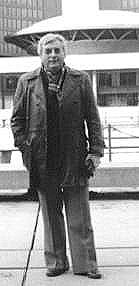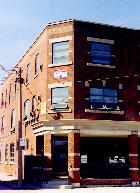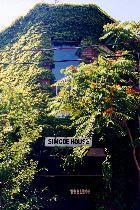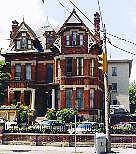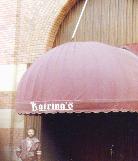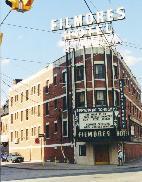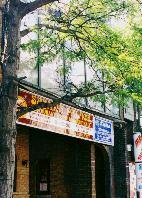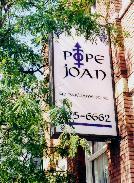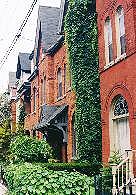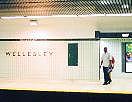|
Promiscuous |
|
Hislop hustles On the hustings, that is
I want in!
|
"Whoever you vote for, the government will get in." Well, sure -- but this year electoral politics would churn up the gay grassroots. We wouldn't be the only ones keeping a close eye on the results.
1980
This year begins and ends with politics. Not unusual for The Body Politic -- but the particular brand this time was one we had often disparaged: electoral politics. More than once we had quoted that old (if grammatically incorrect) line: Whoever you vote for, the government will get in.
The first Canada-wide gay group, the National Gay Election Coalition, had been born of electioneering, during the federal campaign of 1972. But the next year it evolved into the National Gay Rights Coalition, addressing wider issues. It remained as it had begun not an insular lobby on Parliament Hill but an alliance of local grassroots gay groups. Most gay political action was intensely local. We liked it that way: real power had to grow from the grassroots. This year in Toronto, electioneering would vigorously churned up the turf.
The Body Politic's first issue of 1980 featured an interview by Chris Bearchell and Ed Jackson with Toronto mayor John Sewell. Looking back on his five minute speech at TBP's rally a year before -- and on the ensuing uproar -- he had no regrets. "There was a large community of people who felt very much that the world was after them," he said. "I thought that the appropriate thing for the mayor to do was to say: all that's crazy." Sewell was facing an election battle, the vote due in November.
In the same issue George Hislop appeared, standing in front of city hall. On December 10, 1979 he had been elected by city council to a three year term on the planning board, making him the first openly gay person in the city's history to serve in civic office. Now -- despite charges still pending against him since the raid on The Barracks -- he planned a bid for city council itself.
Hislop's run would occupy three lead news pieces, many smaller ones, and two big features in TBP this year -- to the irritation of some readers living outside the city. More than two thirds did, half of them across Canada and the rest beyond, mostly in the US. Gay politics may be local but, we'd be reminded, Toronto isn't the only locale.
To us in 1980 it may as well have been: Toronto's civic campaigns became the country's hottest bed of grassroots gay activism. Buddy's was no longer just a bar: it was campaign central.
The police kept a low profile this year, at least in Toronto, perhaps waiting out the results of those elections. On Halloween, for the first time, after years of community pressure, they'd prevent hostile crowds gathering for the now nonexistent drag parade from The Parkside to The St Charles.
But in Montreal cops were busy, raiding Sauna David April 25, charging 61 men as bawdy house found-ins. The next night more than 1,000 people were in the streets again, this time not met by the riot squad. Some in that demo carried posters reading "Oui!" -- the crowd chanting: "Gays! We say yes!"
Not to the police, of course: to the Parti Québécois campaign to win a "Yes" vote in the upcoming referendum on sovereignty association, a soft pedalled brand of separation from Canada. In its June / July issue TBP ran that same poster over a related story and an editorial backing Quebec's right to self determination. After all, we were fighting for self determination, too.
The "Yes" side would lose that time, 60 percent voting "No." But 15 years later we'd see a replay -- one breathtakingly close.
Michael Wade's journals are filled with tales of "going in" -- bringing in a great deal with him. These are from Jan 4 & 20, 1980.
"Why am I not just frigid -- scared shitless of people? What are my trust & my motivation? I'm so rarely satisfied with what goes on in my life, but I always thought I was overdramatizing everything. Now I've found out I've been inordinately low key. Doesn't everyone go through life with humiliations about the past, confusions between emotions & commitments, feeling lonely at night, getting cold stares, remembering the results they got in public school, reshaping thoughts until their rough structure is nearly as symmetrical & self supporting as it can be?
"Doesn't everyone see the beauty of a mauve sunset reflecting off the highway, of a grey pane of glass, of the lack of reasoning that occurs in some emotions, of the feeling of sheet ice underfoot, of Toronto at five in the afternoon, of the smell of sweat? It's those lovely things that defy description or logic, those beautiful, sometimes intangible events or sensations that keep me going all the time."
"I went to the Manatee last night with Kim. Saw the drag show. One of the acts came into the audience & started being very stagey- seductive with me. T'was quite a night.
"On our way back, Kim was more or less giving me an impromptu lecture on the virtues of gay clubs & discos & all. I felt then, as I have been feeling for the past two months, like such a novice.
"Every gay man I talk to -- Rick, Paul [Aboud], Kim [Krause], Paul Pearce, Robin [Hardy] et al -- has had a fair amount of experience with the whole affair & I have to talk to them on that same level. My stories are nothing new, really. It's just that they're fascinating to me & no one else.
"It's all set for me. I have a place to stay, some objectives to reach (learn to draw, learn about how I can approach my new- found sexuality, learn to live by & with myself), & an itch in my head. I just now have to go jump on it. It'll probably be one of the best things I've ever done for myself.
"If I'm ashamed to be a movie, the best thing to do is stop being one."
- Michael Wade's journal, April 28, 1980:
"When I go to Toronto and Rick and I go to Gerald's place, I feel very uncomfortable -- I mean, let's face the facts, Wade: If it weren't for Ricky I wouldn't be there; I'm always, it seems to me, in Ricky's shadow. They all seem so much more advanced than me.
"I should, then, be yearning to meet people closer to my own age. But no. When Robert Trow says that Billy was just 'bouche fermé,' that sense of humour comes from a sophistication of speech that I would rarely find in someone my own age, and that I want to pick up on by hanging around with Ricky and his pals.
"I love Ricky because he's introduced me to a whole new way of thinking and being, and his friends are part of this. But, all the same, it is frustrating. I don't talk a lot when I'm with them simply because I don't believe they're interested in listening to the observations of a green kid -- and why should they be? I'm there because I'm Ricky's boyfriend; my silence is tolerated because I'm Ricky's boyfriend. I hate that.
"What I hate more, I think, is when I do say something which they find interesting or funny, and I find myself trying to memorize what I'd just said, or how I'd said it, because that was the intelligent thing to say and I must remember to say things like that in the future. What bullshit!"
Michael could be endlessly insecure, afraid he wasn't going to meet the standards -- and they could seem high ones -- of total immersion in this new and intensely gay world.
But people did like him. Once after a big dinner, eight of us at two tables, I at one, Paul Pearce at another, Mikey not there, I asked the others how their conversation had gone. "Oh fine," someone said. "We were all given a 20 minute lecture on the virtues of Michael Wade by Paul Pearce."
I told Mikey that, of course; he was proud but a bit baffled. Paul urged him on: "Nothing's gained by holding back," he said, "just get in there and say what you think" -- certainly Paul's own guiding principle. Mikey did try to take it up. Later in the year he'd make notes on a dinner at the Pearce Newcome residence:
- "Paul got bored and pointed out that we were all just a bunch of aging homosexuals. 'Except for you, Michael,' he said. 'You're just trying to become an aging homosexual.' Paul Pearce strikes again."
Paul might have made the same exception for another young man, if not at that dinner then many others. Denis Fontaine was just a few years older than Michael but could look younger, a tiny blond creature often quiet as well until some giddy moment inspired his happy, high pitched laugh.
Denis, like Michael, could seem an attachment: to Alan Miller, a volunteer at the Archives since 1977 (there still more than 24 years later); or to Gerry Oxford, a TBP regular since 1978, when Ken Popert picked him up at Gaydays. But Denis was part of the paper's extended family in his own right, his entrée The Upper Crust: he'd worked at the plant. Paul joked that the huge mechanized dough mixing bowls were nearly as big as Denis himself.
Soon enough he was at 24 Duncan, running the mail order book service. Denis would see some rough times in his life; we'd then see his core of steel. If one nicely wrapped: over 40 now, Denis still looks a pup. I see him rarely, but when I do I always want a snuzzle, a kiss. And I get them. Robert Trow, his later lover, never seemed to mind.
|
New joints
Industrial (non) chic;
From one hotel to another:
The Manatee gets company:
|
|
Lesbian bars: fickle fate
Take a Fly:
|
"Bar-hoping"
Yes: "hoping," not "hopping." The cover draw for Chris's 3 pg piece was "In search of the perfect lesbian bar" -- "the perfect" slashed over, replaced by "any." Tales (& pics) here of The Cameo Club, The Bluejay / Déjà Vu / Eve's, The Fly By Night, & Together (see 1986: Jan - Apr).
For more on The Fly, see Becki Ross's The House that Jill Built. For a later view of the (still nebulous) dyke scene, see 1987: Aug - Dec.
Chris Bearchell, TBP, Oct 1981.
Poppers
Poppers, commercially sold, were a liquid solution of butyl nitrite, when inhaled causing dilation of vessels & a rapid drop in blood pressure -- giving a "rush" (one brand was called Rush) as the heart raced to get things back in balance. The term was originally singular, a glass ampule "popped" under the nose: amyl nitrate, a prescription drug meant (by the same means) to ease the pain of angina.
This came home to me at Fruit Cocktail, 1983, when playwright John Herbert (of Fortune & Men's Eyes fame) sang a parody of "Lili Marlene" called "By The Barracks Light," one line (my emphasis): "Give me a popper just to show you care, & a bar of soap, but not to wash Mein Herr." (John was ever in form; he died, age 75, in 2001.)
In the mid 70s neck chains or thongs dangling a metal capsule -- an inhaler holding a popper -- were a chic gay fashion accessory on dance floors. Minor entrepreneurs attuned to the "gay market" soon sold butyl nitite (& similar variants; amyl on offer only by scrip) in little brown screw top bottles, then for about $5 apiece. These got called poppers (plural), common too on dance floors. And in bed (or wherever). Their effect on sex was dramatic (if brief), not just a rush but a letting go, an easing of muscles -- a great aid in various receptive acts.
Before HIV was discovered poppers were cited among many putative "lifestyle causes" of AIDS. They can be immunosuppressive if overused, but clearly don't "cause" AIDS. That's never stopped the lifestyle police decrying them.
Despite a (variously enforced) federal ban, poppers can still be had -- carefully (& much more expensively) sold as "video head cleaner."
("...it is very strange now trying
to describe it to you...")
But even in my unintended if inevitable shade, Michael managed to grow. About one of his trips back to Oakville he wrote: "I carried copies of The BP home with me, and I carried them with the title out, so everyone could see."
The date of that entry tells me it was the March 1980 issue, Mikey himself on the cover. "That makes me pleased with myself," he wrote. "It's an elaborate way to come out I guess, but it's novel enough to make it worthwhile." Just after that he reflected on what his life might have been like if we hadn't met that night on Paul Aboud's living room floor:
- "I'd believe in heterosexuality and I'd believe that homosexuality was a wish fulfillment of adolescent adults. I would try to make myself look straight; right now I try to make myself look like a faggot -- I love it! I'd be bored, frustrated, lonely. Rick... I love you. 'POOF!' [this in a big starburst; then a surprised character with a word balloon]: 'Everything's changed!'"
Drawings and cartoons filled Mikey's journals, his characters' expressions created (as were Gary Ostrom's) with a marvellous economy of line. He would leave me cartoons as notes. One was about leftover chowder I could heat up, or chuck lest it go rancid, the "mad chowder" a little pot looking quite miffed. My favourite had a little man in a box, subdued, his hands folded; "Ricky...?" his balloon read -- then, unboxed, arms waving wildly, "I bought Ovaltine!"
Mikey's journals were also full of writing beyond his recounting of the times. There were scenes, often from life and in dialogue, that he'd later work into short stories. There were drafts of reviews, almost all on films.
Mikey knew lots about film. (One of his drafts ended with a little character saying, "So that, my dear, is what the modern cinema is all about.") In April he applied for a job at the Canadian Film Makers' Distribution Centre. He didn't get it, but worked there over the summer as a volunteer.
In time those reviews would be not in his journal but in The Body Politic. Stuck in my orbit, Michael made a place for himself there (a pattern he'd repeat with later lovers, taking up their interests as his own). In 1982 we'd publish a major piece of his, paired with another by Robin Hardy and featured on the cover, about the films of Kenneth Anger.
I knew Michael would someday have to find himself outside my orbit. But in the meantime there wasn't much I could do about the paths he chose. Often enough they led in happy directions. In May he wrote a poem in his journal inspired by -- big surprise -- Frank O'Hara, and his poem "Ave Maria."
It begins: "Mothers of America / let your kids go to the movies!" Frank's advice was not only for "the soul / that grows in the darkness, embossed by silvery images." Your kids may, he wrote, "even be grateful to you for their first sexual experience."
- "Oh, Mr O'Hara! I will be sending my kids to the movies.
I'll send them by bus, car or plane.
I'll push them out the door, drop them down delivery chutes or
pack them in crates.
But they'll get there.
And when they walk out their hands won't be in their pockets.
They won't be opening wallets to retrieve car fare.
They won't be talking.
They won't be sighing.
You know what they'll be doing, Mr O'Hara?They'll be dancing."
We got a few more place to dance (or not) around this time, new bars opening if some not lasting long. The Side Action Lounge at 212 Dundas East had come and gone within months in early 1979 -- though we'll see that site again.
In October of that year a full page ad in TBP announced "Gunars, opening soon." There was no address. That ad ran through March 1980, no expense spared it seemed. Finally the place opened -- in Yorkville, hippie heaven in the late '60s but now gone upscale. By the end of the summer Gunars was gone. Yorkville would be bad luck for later ventures as well.
In the August 1980 issue we got notice of Gunsel's at 529 Yonge, across the street from The Parkside. Perhaps inspired by that proximity its ad read: "In the midst of the madness, not just the same place, a meeting place." It was a piano bar, with "Lunch, dinner, and Brunch on Sundays."
It lasted just long enough to serve as a "typical" gay bar for a CBC docudrama, The Running Man (plot: closeted track coach rebuffs sexually confused student; kid kills himself). David Mole, writing about it for The Body Politic, sat in on a scene:
- "'Action.' The sound comes up (second rate bar disco) and the 'special business extras' who have been collected for this scene begin to move to the beat, smoke cigarettes, sip drinks, talk, cruise, fondle, kiss and generally do an odd, lurid version of the gay bar thing in front of the CBC film crew."
The site of Gunsel's would have a later gay history, as would other new spots, even some off the beaten track. Former out of town guesthouse owners George Pratt and Dave Davies opened a place at 18 Eastern Avenue, near King and Parliament, far south and east on the verge of industrial land -- and fittingly: they were after men who, in New York, might have "done the trucks" -- haunting parked tractor trailers.
George and Dave, calling their bar 18 East, did offer one outdoor amenity: a small back patio. But the real action was indoors -- in the main floor bar, in a basement occasionally qualifying as a backroom in the traditional sense, and I'd imagine upstairs: the building was a hotel. The main room was decked with motorcycle club regalia, trophies in glass cases over the bar. There was a café too, big windows; in all a nice place for a treat -- of many kinds.
I once watched a man there, a noted aggressive S/M bottom, put on a dog collar and then hand another guy a leash. He made that man chase him all over the joint -- in the bar, out in the back, down in the cellar -- trying to rein him in. He soon surrendered: last I saw they were in the basement having a fine time.
Later 18 East would be The Rendezvous, looking for lesbians and not having to look far: around the corner on Trinity Street was The Cameo Club, opened it the mid '70s -- a dingy, basement dyke bar.
The city's few lesbian venues, most open only on weekends, tended then toward the east end: The Bluejay on Pape Avenue, later Club Déjà Vu, by 1981 Eve's; and The Fly By Night, in the back of the Stage 212 Hotel on Dundas East.
"The Fly" as it was dubbed opened in 1979, a rare attempt by political lesbians (among them Pat Murphy, once of CHAT) to give women a more congenial space than usually on offer, and six nights a week to boot. Among those often there -- notable for not being in then obligatory dyke activist drag: plaid shirt, jeans and construction boots -- were strippers taking a break from their labours at the front of the 212. Phil Stein, of The Quest, would buy the whole place in early 1981, soon giving those uppity women 15 minutes to take a fly and get out. They organized a boycott of The Quest.
The Rendezvous lasted just a few months, the place reopening in early 1983 as The Toolbox at 18 East: "the bar with balls" (balls, in fact, with a dick in chains making the "oo" in its name). In 1984 they'd try a disco downstairs; the leather boys hated it.
By late 1986, 18 East would close, but the Toolbox lived on (and does to this day), still on Eastern Avenue but much farther east, well across the Don River at number 508 and still a hotel: the Simcoe House.
Closer to the main action, at 80 Charles East, off Church north of Wellesley, we'd get another hotel bar. It was in a sub-basement of the Waldorf Astoria, like its New York namesake actually two separate structures built, they looked, as late '50s modern apartment blocks. (They're now renovated as expensive fake French Provincial condos.)
Among Boots' owners was Rick Stenhouse, erstwhile gay activist connected in this effort (and in The Barracks, Rick among those under charge) with Jerry Levy -- who could have been The Village People's leatherman, rarely in leather if always cropped black hair, a big black moustache and a severe demeanour. Jerry, Rick and others also owned RLS Management, its office at 66 Gerrard East, above Crispin's. They did a booming business in poppers.
I recall Boots at the Waldorf, if better Boots at the Selby, its incarnation from the summer of 1981 at 592 Sherbourne Street. The place had a less famous name if more noble heritage: built in 1883 as home to Charles Gooderham, heir of the famous distilling family, it had also been home, during his early career at The Toronto Star, to Ernest Hemingway.
Papa might have been unsettled by later goings on downstairs, butch as they often were. One of the two big spaces there had a long, four sided bar in the middle, a dance floor on one side, banquettes on the other. Those seats soon went to more casual fixtures -- including a big motorcycle. But the overall flavour was less severe, dancers there in varied attire.
Across the hall was a traditional men's tap room -- in form: tables and chairs and draft if you wanted; but women were allowed and there was beer by the bottle as well. This was Bud's, the same management but a different feel. Different again was The Courtyard, open by the summer of 1985 in a space beside the hotel with a tall wooden fence and a pretty gazebo over its bar.
Boots, Bud's and The Courtyard drew big crowds. By the early '90s that crowd would be quite varied, not entirely gay but decidedly kinky, on special "Fetish Nights." Bud's would later be The Kurbash, serious attempt at a sex club. If briefly: as everywhere, the scene would shift, then shift again.
At the Selby, ownership would shift too: in 1999 the hotel, long run by Rick Stenhouse and company, was bought by the Howard Johnson's chain, not boding well for its homo haunts. Just before the summer of 2000, the Selby's bars and the courtyard -- by then among the oldest gay venues in the city -- were closed. Some saw this as further evidence of the scene's consolidation on Church Street, by then very much Toronto's gay mecca.
But it hadn't been the first contender for the title.
|
Parliament Street (Gay ghetto not to be)
580 Parliament:
547 Parliament:
Cabbagetown streetscape:
Wellesley subway station:
|
Among the longest running was Peter Brown Travel. Peter was lover to real estate mogul Darryl Kent, who made pots of money selling houses in Cabbagetown to gay men, often couples. They "white painted" (more often sandblasted) those Victorian beauties, long neglected by everyone including their working class tenants, into gentrified splendour. Intent on tarting up the area, Kent once got a gas station on Parliament, Cabbagetown's main drag, to do itself up in fake Victorian brickwork.
He died a few years later, a brain hemorrhage while on a trip to South America. At the west edge of Riverdale Park, near the kiddie farm, there's a plaque for him -- on a bench facing not the park but across the street, to his house. His greater memorial is the entire neighbourhood.
But as ghetto central Parliament would in time lose out to Church, the subway a deciding factor. Parliament's scene was far east of the Yonge line, far south of the crosstown route beneath Bloor. Church & Wellesley was closer to both -- giving weekend tourists just a short stroll from public transit to transit gloria homo in the bars and clubs that would boom there by the late 1980s.
And Parliament never lost its working class edge, with St James Town north of Wellesley an eventual highrise slum; south of Gerrard Regent Park, a late '40s public housing project, replacing the original Cabbagetown, named for its front yard veggies.
It would have a lesbian presence: at 547 The Purple Onion briefly hosted a club called Lois Lane in its basement, the Onion in time becoming The Rose (now Pope Joan), the longest lasting lesbian venue. Number 580 would lose Lipstick and Tiverton's, but be for a while The Women's Common.
It's still a great street, if one (perhaps thankfully) not destined to become a gay theme park.
On St Joseph Street, The Manatee got a neighbour. Katrina's opened in early 1980 in one of the old Rawlinson warehouse, at first with pretensions to class -- and camp. In TBP's April 1980 issue it ran its full menu, among the items: Cod Tongues Dildo, "a Newfoundland delicacy"; Crudité Fire Island; The Mineshaft, a burger with "chunky" fries for $4.50; and Red Snapper Key West, $7.00 -- these prices a bit pricey for the times. * (See note below)
But Katrina's would be less famed for food than for cute boys -- the Mr Blueboy of Canada Contest held there in October 1980 -- and for dancing. In December 1981 it would become KT's, with a stand up bar and big disco floor. Within months it was Katrina's again, later with a new disco upstairs, Voodoo. That would become Club DOC, then Back Street.
Later the whole place would relaunch as Colby's, its tagline "Toronto's Gay Entertainment Showplace," the "Flashdancers" as chorus line. In time dancers there would flash nearly everything. By then I'd know Colby's quite well.
Of Katrina's in 1980, I knew only Norman Hay. He dished out food there -- from the cheaper weekend buffet, not that more upscale menu -- to disco bunnies. He said it made him feel "grandfatherly."
Norman, that man I'd met years before with Vincent Warren in Montreal, was 56 years old now and a bit down on his luck. He'd had a remarkable career as a designer, his work including the site plan for Expo '67 in Montreal. He'd been the lover of Alan Jarvis, curator of the National Gallery of Canada, a man who ended his days in a mess of booze. Norman nearly followed him.
But I didn't know any of that then. Norman didn't drink anymore but wasn't religious about it. In fact he was never reverent about anything, having learned through a hard life the value of facing the world with a good line. His favourite: "Fuck 'em if they can't take a joke!" He enjoyed life's eroticism, if always in an easy, gracious way. He did volunteer work at The Body Politic, brought there I think by Robin Hardy; they were great pals.
Norman, of a generation one wouldn't blame for having turned out paranoid, pinched and mean, was a sheer joy. He inspired us, too often a solemn lot in print (for a joke we once titled a news item: "This is a happy story") to real joy in ourselves. "We're wondrous," he'd say. "We should celebrate each other."
We started a regular feature for precisely such celebration, and called it Upfront. Norman Hay wrote the first one.
Canada's national gay & lesbian movement
As noted, Canada-wide organizing began in 1972 with the National Gay Election Coalition (NGEC): 16 groups coordinated by Toronto Gay Action. In May '73 Gays of Ottawa hosted 60 delegates, most from Ontario, to revive NGEC & plan a national Pride Week, Aug 17 - 26.
A Quebec City meet (Oct 6-7 '73; 80 delegates, 20 groups) was the 1st truly national gay confab. Winnipeg, Aug 31 - Sept 2 '74, saw 24 groups & the first gay march on the Prairies. At Ottawa, Jun 28 - Jul 1 '75, the National Gay Rights Coalition / Coalition nationale pour les droits des homosexuels (NGRC / CNDH) was born.
For details, references, & issues of the day (to 1975), see Don McLeod's Lesbian & Gay Liberation in Canada.
Then: Toronto (Sept 4 - 6 '76), Saskatoon (Jun 29 - Jul 5 '77), Halifax (Jun 28 - Jul 4 '78), Ottawa (Jun 27 - Jul 2 '79), & Calgary (Jun 27 - Jul 1 '80) -- all amply covered in TBP.
In 1978 at Halifax the NGRC was renamed the Canadian Lesbian & Gay Rights Coalition / Coalition canadienne pour les droits des lesbiennes et gais (CLGRC / CCDLG) -- not only to add "lesbian" but cut "national," seen as an affront to Quebec's distinct national aspirations.
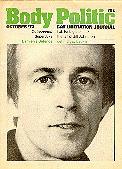
The case of John Damien
|
By 1980 CLGRC was moribund, disbanding at Calgary, replaced by the Canadian Association of Lesbian & Gay Men, a more classic lobby group; it failed to gain grassroots support & soon faded. Provincial coalitions -- most gay issues, protection in human rights codes especially, were local or provincial -- lasted longer.
There were also more focussed gatherings. Women came to Toronto from as far as Montreal & Vancouver for the 1st lesbian only confab, Jun 30 '73. Lesbians of Ottawa Now (LOON) hosted the 1st official National Lesbian Conference Oct 9 - 11 '76, with 350 attending.
Toronto saw the 2nd, May 19 - 21, '79 (then called "bi- national" -- Canada & Quebec), promoted wth the line: "What do you do with 1,000 lesbians?" About 450 showed up (still more than at most national conferences). Toronto had hosted a bi- national Gay Youth confab May 20 - 22 '78.
Later came Doing It!, free of official formalities, with folks from across Canada & beyond (see 1982: May 31 - Dec).
There was nationwide action (if soon no formal group), 1977 - 1986, on efforts to include "sexual orientation" in the federal human rights act & the Charter of Rights & Freedoms, part of Canada's new 1982 constitution. For the fate of these efforts see the section on federal human rights protection in What we demanded; What we got, an addendum to We Demand in the CLGA site.
In Dec 1986 a new national lobby group formed: Equality for Gays & Lesbians Everywhere (EGALE). Based in Ottawa it raised barely a ripple elsewhere: not a coalition, not representing a broad based national movement -- there isn't one anymore.
In 1999 lawyer Brenda Cossman (Xtra, Feb 25) accused EGALE of avoiding messy issues: censorship; age of consent; draconian laws against "child pornography." Her article's title: "No sex, please: National lobby group stands up for repsectable rights only" -- which meant same sex "spousal" rights (see 1994: Apr - Dec & History: As history).
By 2000, federal law recognized same sex partnerships -- & regulated them, imposing burdens even on those involuntarily "spoused." As Jane Rule wrote:
"If our only proud achievement for the year 2000 is the requirement to declare ourselves common- law partners after a year's cohabitation, I fear that what we have chiefly done is to invite the government back into our bedrooms after over thirty years of relative privacy."
EGALE barely noticed, marching on with a battle cry long heard in the US if not in Canada: "Gay Marriage!" A movement born in resistance to state definition of relationships now demanded it -- in the name of "equality."
For much (much!) more, see:
Gay marriage? Wrong question
- Michael Wade's journal, June 24, 1980:
"The most amazing thing happened yesterday morning. I was with Ricky in his kitchen and he said something in a mock bitchy way. So, I responded using the same tone. It became a showdown.
"He pinched his lips and squinted his eyes and spat out, 'Yneah?' I shook my head and looked at him in profile. 'Yeh!' Ricky squinted more and grimaced, trying to complete the joke... but he couldn't: the fact that we were joking together overrode the actual joke, and I broke into a smile. Ricky laughed, and hugged me.
"He's in Calgary right now, speaking at a gay conference at the university. I'd love to be there right now watching him lecture. I'd be so proud of him but at the same time I'd think it was hilarious."
Michael overstated my role. I was in Calgary to listen, not lecture, with Gerald Hannon, Chris Bearchell and Paul Trollope, at a national gay conference, the eighth; they'd been held since 1973, in various cities. The National Gay Rights Coalition was formed in 1975; by 1978 it was the Canadian Lesbian and Gay Rights Coalition -- many groups with "Gay" in their name adding "Lesbian" around this time.
In Calgary the main business of the coalition turned out to be its dissolution. Gay politics were indeed local, or at their widest provincial: that's where battles to ban anti gay discrimination in human rights laws were being waged. So I was in on Canada's national movement just as it ended, regretting its demise less than others, Gerald especially, who had lived through its most glorious moments.
Those gatherings could be magical, but could also be a bore: gay people were not so gay in endless debates, plenaries, procedural wranglings. Michael was right about the university: it was usually in such places that these things convened, far from whatever gay life the host city might offer.
And everybody had to get up so damned early.
We Beepers were there not just to confer but to do a big piece on gay life in the city. Gerald and I got to see Calgary's own Parkside, nothing like Toronto's: The Parkside Continental verged on chic. We talked to members of the Imperial Court of the Chinook Arch, gay emperors and empresses a western number then, odd to us Central Canadians. In time we'd see coronations back home.
We even went to the baths: Jay's Relaxation Centre sounded more congenial than the Dip'n Dash. It was one of my rare trips and with my usual success: in a towel I look like a raw turnip.
I interviewed Bob Harris, of Gay Information and Resources Calgary, at the King's Arms, yet another hotel tap room, this one at the Palliser, quite grand. The hotel, anyway: its homo haunt was usually called "The Pit." Bob was a tiny man, very intense. Looking at a press photo of him at the gay centre, someone over my shoulder said, "There's Bob -- life size."
I found his size just fine, flirting as I took pictures of him for the story. He and I had a nice little affair for those few days, ending up in bed often. Bob wrote to me after that, his letters usually including news for the paper. He'd later move, becoming one of TBP's Vancouver correspondents.
On the plane home I discovered I wasn't the only one to have connected there. Paul Trollope was in the seat beside me, at times in tears. Seems he'd got quite attached to a handsome Calgarian. Romance did not come easily to Paul, I imagined, and here he was flying home and leaving that man behind.
I did warm more to Paul in that moment; in fact had before. His big face could light up with great laughs, particularly at political jokes. It was Paul who came up with a pointed moniker for Gary Kinsman, a fellow Trot if more grim than Paul, always correct and an endless critic of TBP.
Ed Jackson would once call him a "slimy opportunist." Paul's jibe was more subtle: "Gary Kinsperson."
Back at the paper there were new faces. Stephen MacDonald had done a study on The Body Politic in 1976, while in Toronto at library school. That had been his toe in the water. By the fall of 1979 he'd moved from Halifax and could be found at 24 Duncan, bringing a librarian's sense of order to our slapdash works, or trying to, leading the Office Administration Working Group.
We loved working groups (acronymns, too; that one OAWG): mini collectives autonomous from the collective proper (unless they really screwed up). Robin Hardy later recalled me showing him, as a new kid, our structure: not a laddered hierarchy but a Venn diagram, lots of ovelapping circles.
Stephen would later write:
- "Coming to work at TBP was an explosion of new ideas and experiences. We made life long friends and had terrible arguments. We had love affairs and we marched in the streets. We were arrested by the police and we learned to take care of each other. We worked together and we changed the world a little bit."
He would be around for years. So would John Allec, a tall gawky boy new in town this year from Winnipeg. He'd been reading TBP, imagining Beepers "a Valhalla of demigods." Soon he was among them, the only gods in his head -- Wagnerian ones roaring from his Walkman as he typeset. He wrote music of his own too, when not working full time at the Red Cross on top of some 20 hours a week at The Beep.
John seemed a bit mousy at first. In 1981 we'd see that the mouse had claws, rarely exposed but with considerable effect when they were. He also wrote very funny stuff, his humour madcap. Once captioning a pic of Margaret Mead's study on coming of age in the South Seas, he alluded to a tune then big: "You Got to Give Me Samoa."
I once captioned a shot of performance artist David Roche -- in a big dress shirt on backwards and clutched at the back to give it a waist, making a nice chemise: "Not a damsel in this dress. (And not a dress.)" I had to apologize later to John: it was his line. He'd once tell Gerald he got irritated at me "acting as editor of the collective and putting the final stamp on things." He was right.
Roger Spalding had bought the first issue of TBP at The Parkside in 1971, just out of the seminary then; he'd read every issue since. He figured he wasn't political enough to get involved but by 1979 he had -- and found Beepers "just your ordinary homos." He taught at an alternative school, a few of his students sometimes around the office. A couple of them later came out.
Leo Casey was from New York, in Toronto for graduate school. He had a fierce red beard and a seriously leftist demeanour -- at first. In time he was rubbing Gerald's bum. Leo often wore an odd indoor coat, rough woven, I think North African. When he went back to New York in 1982 he'd leave it behind: the Leo Casey Commemorative Wrap I dubbed it, warming me on chilly night shifts.
John Allec would appear wrapped in it in TBP's 100th issue -- in drag as journalist "Barbara Amyl," reporting on our millionth. The real Barbara Amiel, Toronto Sun columnist and later Mrs Media Mogul Conrad Black, would likely have been less celebratory.
Ross Irwin was from Saskatoon, involved in the movement there and now in Toronto, just out of law school at Queen's University in Kingston. He was teaching then, would later have a law practice. I had fallen in love with a picture of Ross in a 1976 issue of the paper, so big and blond and trim. We did do it, once, before he became a Beeper himself.
By the fall these new faces could be found at the collective table, often pondering our court cases. Stephen MacDonald, Tim McCaskell and others had arranged a big ad in the February 6, 1980 Globe and Mail, signed and paid for by 800 people, headed: "We urge the Attorney-General of Ontario to drop the appeal against The Body Politic. Not guilty means not guilty."
On March 7 County Court backed the Crown's appeal of the verdict: not guilty meant let's just try it again. On the same day we appealed that decision to a higher court. So the case dragged on.
In December 1979 a judge (coincidentally, wry Sid Harris) had ordered return of all material seized in the raid on our office two years before. In January the Crown appealed that order -- so that case dragged on, too. Both would, well into 1982 and beyond.
One day in September Mikey called me at the office, having been out of touch for a day or two. He told me he'd met a man named George. I felt my stomach drop all five floors to the ground, but recovered soon enough. We had never committed ourselves to monogamy, few of us in those days believing in it. I'd told him about Bob Harris; he'd been bothered for a time but then not.
Now it was his turn; he would take many, George far from the last. In sexual exploration Mikey would go in much farther than I, discovering techniques I barely knew and finding passion that had faded with me: in bed we had come to be comfy old shoes.
But it was that comfort than made his wanderings all right for me: he'd always come home -- and tell me about them. Or most of them: I'd later get to read of the few adventures he feared might bother me then. He was right: they well might have.
In November George took Michael to The Club, his first visit ever to the baths.
- "George had the room; I had the locker. Maybe I'm naive, but I didn't know that George's plan of action was to use the room with somebody else -- which is what he promptly did. He let the boy into the room, waved 'bye bye' to me, went in and shut the door. Shocked? Was I shocked? Lord, I was shaking!"
Paul Pearce, over a later dinner, told Michael that what George had done was "oily." Maybe, if another lesson worth learning.
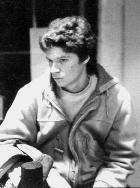
Awaiting the verdict:
|
We headed off to city hall with Ed Jackson, he an avid reporter by now and set to write that story. The rotunda was crowded with reporters, monitors showing results as they came in, and lots of anxious homos.
Rightly anxious: the first reports, from the business district of Ward 6, showed George Hislop well behind. That never changed. George lost, coming in third behind a Tory dentist and a socialist Anglican minister.
But the mayoral race was a cliffhanger. Sewell had backed Hislop, leading to dark rumblings that the "homosexual lobby" was going to take over the city and turn it into "San Francisco North." The religious right -- and the police -- had been rabid about Sewell & Hislop all through the campaign.
The mayor was facing Art Eggleton, a nondescript alderman. (Ken Popert once asked Eddie, just off the phone with him: "How's Art? Still imitating life?")
One minute after the polls closed, the CBC declared Sewell the winner. That was premature. Sewell did get 13,000 more votes than in the three way race he'd won in 1978, but by the final tally at 10:30 pm he was 2,000 short of Eggleton. City council ended up with only nine members on the left, 13 moderate to right wing.
At the St Lawrence Market, where more than 1,000 had turned out in hope of a victory bash, George spoke: "The amount of love that has been shown toward me and our community in Ward 6 has vastly outweighed the hate we have seen demonstrated." John Sewell, speaking at 58 Cecil Street, once home to CHAT, now a community centre, said: "Don't give up on the city."
We did not give up. But others -- who kept as careful an eye on those election returns as we had -- did not give up, either. They had their own plans for the city.
* Postscript, 2008: In April 2008, I got e-mail from an early fan of Katrina's, saying the club opened not in 1980, but 1978. I can't now recall what source led me to the later date; 1978 is amply supported by evidence offered in that message, along with fond recollections of other gay venues of the day. So: With thanks, I'll take the word an attentive reader who clearly knew this town's late-'70 club scene.
Go on to 1981
Go back to: Contents page / My Home Page
This page: http://www.rbebout.com/bar/1980.htm
December 1999 / Last revised: June 18, 2003 / Note added: May 22, 2008
Rick Bébout © 1999-2003 / rick@rbebout.com
